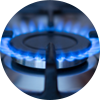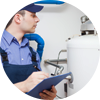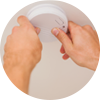Carbon Monoxide, also known as the Silent Killer, has contributed to more than 400 deaths per year. Carbon Monoxide (CO) is a gas that is both odorless and colorless. Because it is not obvious to our five senses, it is extremely dangerous and life threatening.
Symptoms of CO Poisoning
 Everyone is at risk of CO poisoning, but it is especially dangerous for infants, the elderly, and those with asthma. Since it is not easily detectable, the gas can build up in your home without knowing there is a problem. The low to moderate stages of CO poisoning are similar to symptoms of the flu – you will experience headaches, shortness of breath, dizziness, fatigue, and nausea. High levels of CO poisoning include mental confusion, vomiting, loss of muscular coordination, and potentially death. The severity of your symptoms depends on the level of CO and the duration of the gas’s exposure.
Everyone is at risk of CO poisoning, but it is especially dangerous for infants, the elderly, and those with asthma. Since it is not easily detectable, the gas can build up in your home without knowing there is a problem. The low to moderate stages of CO poisoning are similar to symptoms of the flu – you will experience headaches, shortness of breath, dizziness, fatigue, and nausea. High levels of CO poisoning include mental confusion, vomiting, loss of muscular coordination, and potentially death. The severity of your symptoms depends on the level of CO and the duration of the gas’s exposure.
Sources of CO
 Burning fuel produces Carbon Monoxide. So anything burning fuel, including motor vehicles, stoves, heating systems, gas ranges, and fire places will produce CO. And although CO poisoning is more common in the winter months, you can be at risk in the warmer months of the year too.
Burning fuel produces Carbon Monoxide. So anything burning fuel, including motor vehicles, stoves, heating systems, gas ranges, and fire places will produce CO. And although CO poisoning is more common in the winter months, you can be at risk in the warmer months of the year too.
Preventing CO Poisoning
 To avoid the buildup and accumulation of Carbon Monoxide, have your water heater, heating system, and vents inspected and serviced every year. Be sure that all vents from your dryer, furnace, and fireplace are clear of snow and debris. Never run portable generators inside your home or garage. Generators should be at least 20 feet away from your home, away from windows and vents. Don’t leave your car running in your garage and do not use a grill inside. Even with the garage door and windows left open, you’re still at risk of CO poisoning.
To avoid the buildup and accumulation of Carbon Monoxide, have your water heater, heating system, and vents inspected and serviced every year. Be sure that all vents from your dryer, furnace, and fireplace are clear of snow and debris. Never run portable generators inside your home or garage. Generators should be at least 20 feet away from your home, away from windows and vents. Don’t leave your car running in your garage and do not use a grill inside. Even with the garage door and windows left open, you’re still at risk of CO poisoning.
Install a CO Alarm
 It is highly recommended to have battery-operated CO alarms installed on every floor of your home. For the best protection, install multiple alarms that are interconnected to one another. So when one alarm is triggered, they are all triggered. Note that a CO alarm does not take the place of a smoke detector. Your home should have a smoke alarm and a CO alarm. A smoke detector will not detect CO emissions and a CO alarm will not detect smoke, so be sure to have both in your home. In the case that your CO alarm goes off, go outside immediately and call 911. Never try to find the source – let the professionals worry about that, while you focus on your safety.
It is highly recommended to have battery-operated CO alarms installed on every floor of your home. For the best protection, install multiple alarms that are interconnected to one another. So when one alarm is triggered, they are all triggered. Note that a CO alarm does not take the place of a smoke detector. Your home should have a smoke alarm and a CO alarm. A smoke detector will not detect CO emissions and a CO alarm will not detect smoke, so be sure to have both in your home. In the case that your CO alarm goes off, go outside immediately and call 911. Never try to find the source – let the professionals worry about that, while you focus on your safety.